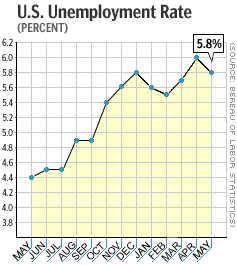
NEW YORK (CNN/Money) -
The nation's employers created fewer jobs than most economists had forecast last month, according to a government report Friday, as businesses proved reluctant to ramp up hiring after cutting more than 1 million jobs last year.
But the unemployment rate took a surprise drop in May, a sign the U.S. job market is not getting worse. Still, economists focused on the sluggish pace of job creation.
"There is a very gradual improvement, but the rate of improvement is painfully slow," said Rory Robertson, interest rate strategist at Macquarie Equities, who expects the Federal Reserve to leave interest rates at 40-year lows throughout the year.
Employers added 41,000 new jobs last month, about half of economists' forecasts, following a downwardly revised gain of 6,000 in April, the Labor Department said. While May's payroll growth was the largest in 15 months, April follows a string of 12 straight months of payroll cuts.
Federal Reserve policy makers, who meet later this month, are not expected to raise interest rates until unemployment shows a sustained drop. That could take time, as companies often are reluctant to ramp up hiring until the business climate heats up.

"I expect several more months of these unemployment levels," Labor Secretary Elaine Chao told CNNfn's Market Call.
At 5.8 percent, unemployment is about where it's been since late last year after the Sept. 11 attacks hit an economy already slowing down. But it's still well below the 7 percent-plus levels seen during the recession that ended in 1991.
Economists surveyed by Briefing.com had forecast a 75,000 payroll gain and an unemployment rate of 6.1 percent, up from April's eight-year high of 6 percent. The drop in the unemployment rate came as the number of employed Americans rose while the size of the labor force was little changed.
But like the labor secretary, Ian Shepherdson, chief U.S. economist at High Frequency Economics, does not expect the unemployment rate to keep dropping in the months ahead. "We are unconvinced this decline will be sustained, but for now it will be read as an encouraging sign," he said.
The job gains in April and May come after 12 months of payroll declines. From the start of the recession in March 2001 through February, job losses averaged 160,000 a month.
On Wall Street, the jobs report did little to help stocks, which fell but recovered from their lowest levels of the session.
The health of the job market bears strongly on consumer spending, which fuels about two-thirds of the economy. After last year's recession, one of the mildest on record in the United States, the economy grew at a 5.6 percent rate in the first quarter. New claims for unemployment benefits fell last week to 383,000, the lowest level since February 2001, while manufacturing has stabilized.
Friday's report showed that employment rose in the services industry and edged down in manufacturing. Most other major industries showed no significant change.
May's 5.8 percent unemployment rate is well above the recent low of 3.9 percent in October 2000. Since then, the number of unemployed has climbed by 2.8 million. Businesses are polled to determine payroll growth while the unemployment numbers come from household surveys.
If the jobless rate is to continue declining, job growth must accelerate. Employment in the services industry rose by 68,000 in May, but manufacturing jobs edged down by 19,000 in May.
Average hourly earnings increased by 3 cents in May to $14.70, the government said. The average workweek was unchanged in May at 34.2 hours.
"The continued flat payroll growth, along with little change in aggregate hours worked, is consistent with employer reluctance to hire early in the recovery," said Susan Polatz, associate economist at Banc of America Securities.
Separate economic data showed that wholesale inventories dropped by a weaker-than-expected 0.7 percent in April.

|

